Integration Management Practices
Added on 2023-04-08
30 Pages7957 Words265 Views
Running head: INTEGRATION MANAGEMENT PRACTICES
Integration management practices
Name of the Student
Name of the University
Author Note
Integration management practices
Name of the Student
Name of the University
Author Note
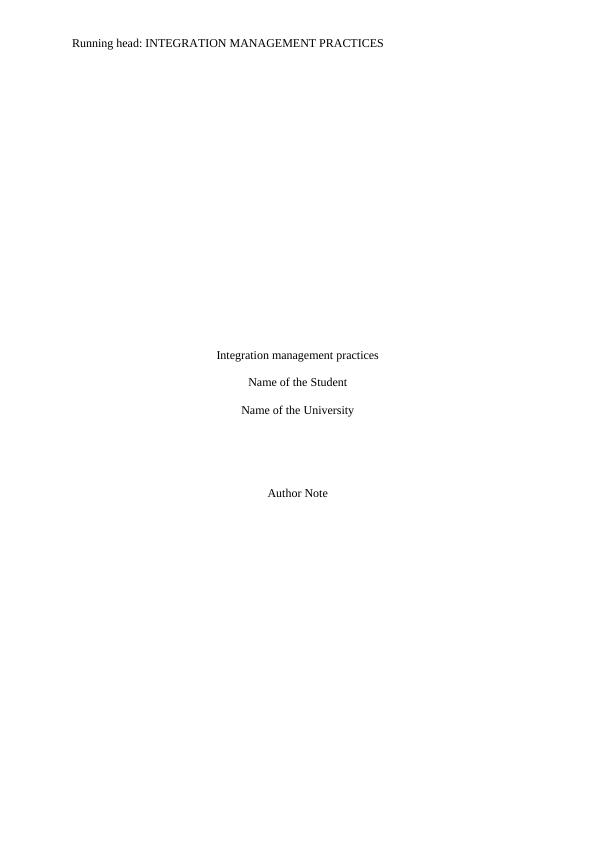
1INTEGRATION MANAGEMENT PRACTICES
Table of Contents
1.0. Introduction.....................................................................................................................3
1.1. Purpose........................................................................................................................3
1.2. Scope...........................................................................................................................3
1.3. Limitations...................................................................................................................4
1.4. Company Background.................................................................................................4
2.0. Resource Integration.......................................................................................................5
2.1. Resource Integration Practices in Air NZ...................................................................5
2.2. Theoretical Approach..................................................................................................5
2.2.1. Effectuation..........................................................................................................5
2.2.2. Configuration.......................................................................................................6
2.2.3. Review of the Problems.......................................................................................6
2.2.4. VRIO Analysis.....................................................................................................7
3.0. Processes of the Organization.........................................................................................8
Internal Analysis....................................................................................................................8
Human resources................................................................................................................8
Tangible Resources..........................................................................................................10
Intangible assets...............................................................................................................11
External Analysis.................................................................................................................11
PESTEL Analysis.............................................................................................................11
4.0. Outline for General Principles Adopted by Air NZ........................................................0
5.0. Key Strategic Concepts for Resource Integration...........................................................0
Total Quality Management................................................................................................0
Table of Contents
1.0. Introduction.....................................................................................................................3
1.1. Purpose........................................................................................................................3
1.2. Scope...........................................................................................................................3
1.3. Limitations...................................................................................................................4
1.4. Company Background.................................................................................................4
2.0. Resource Integration.......................................................................................................5
2.1. Resource Integration Practices in Air NZ...................................................................5
2.2. Theoretical Approach..................................................................................................5
2.2.1. Effectuation..........................................................................................................5
2.2.2. Configuration.......................................................................................................6
2.2.3. Review of the Problems.......................................................................................6
2.2.4. VRIO Analysis.....................................................................................................7
3.0. Processes of the Organization.........................................................................................8
Internal Analysis....................................................................................................................8
Human resources................................................................................................................8
Tangible Resources..........................................................................................................10
Intangible assets...............................................................................................................11
External Analysis.................................................................................................................11
PESTEL Analysis.............................................................................................................11
4.0. Outline for General Principles Adopted by Air NZ........................................................0
5.0. Key Strategic Concepts for Resource Integration...........................................................0
Total Quality Management................................................................................................0
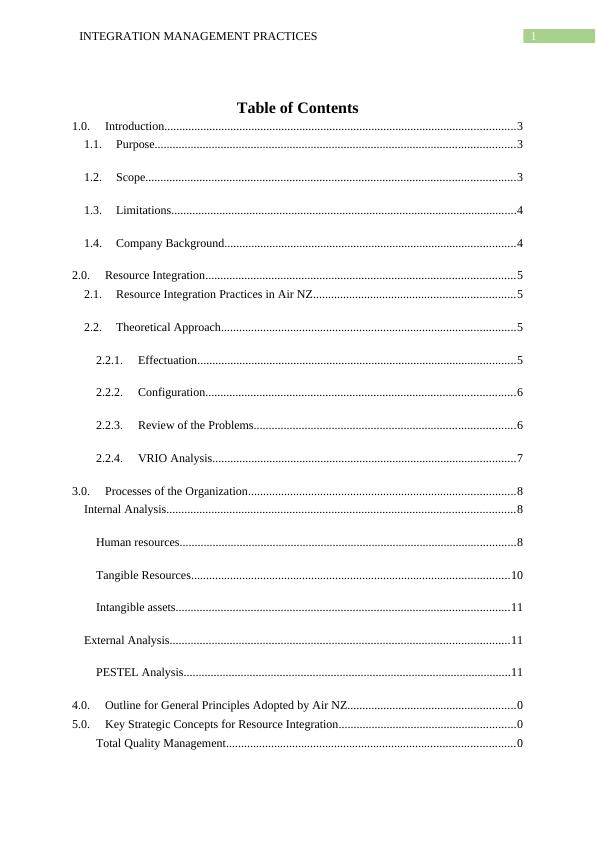
2INTEGRATION MANAGEMENT PRACTICES
6.0. Impact of the Strategic Response....................................................................................3
Lean Production systems....................................................................................................3
7.0. Application of the Systematic Integration of Resources.................................................4
8.0. Range of Operational and Financial Risk.......................................................................7
9.0. Conclusion.......................................................................................................................8
10.0. Cost benefit Analysis......................................................................................................9
REFERENCES.........................................................................................................................12
Appendix..................................................................................................................................14
6.0. Impact of the Strategic Response....................................................................................3
Lean Production systems....................................................................................................3
7.0. Application of the Systematic Integration of Resources.................................................4
8.0. Range of Operational and Financial Risk.......................................................................7
9.0. Conclusion.......................................................................................................................8
10.0. Cost benefit Analysis......................................................................................................9
REFERENCES.........................................................................................................................12
Appendix..................................................................................................................................14
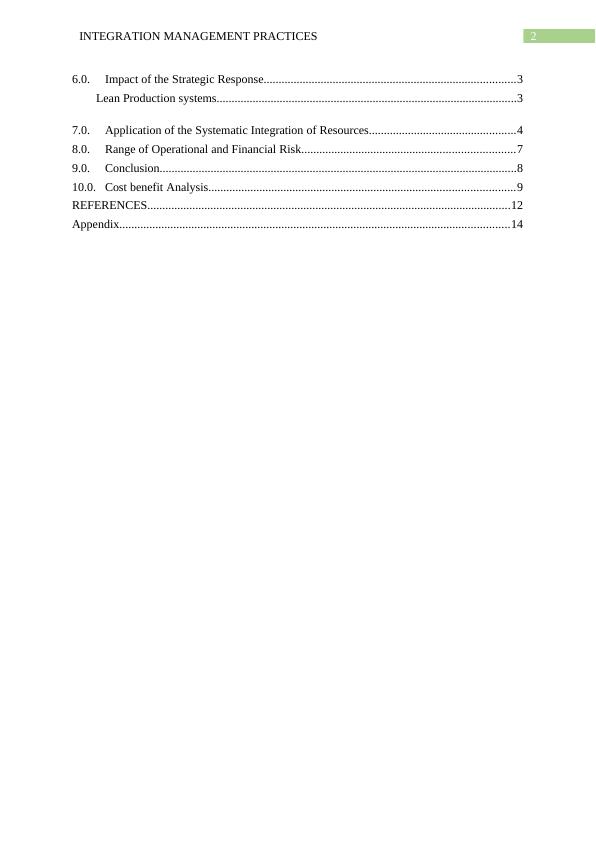
3INTEGRATION MANAGEMENT PRACTICES
1.0. Introduction
Integrated resource management is the incorporation of the factors that will be
responsible for the development of the areas that will be helpful for the achievement of the
desired business outcomes with the efficient utilization of various resources. This is one of
the major activity that will be responsible for the development of the factors that are
associated with the minimization of the operational risks. This is one of the most significant
factor that contributes to the development of the activities such as sales and operations. One
of the most significant aspect of the integrated resource management is the utilization of the
resource that will be liable for the operations and other activities.
1.1. Purpose
The purpose of the study is to evaluate the areas of resource integration management
practices. The study will be discussing the various activities that will be responsible for the
influencing the planning policy. The study will also emphasize on the aspects of the
operational objectives along with the development of the factors that are associated with the
organization. The business and the operational settings will be also elaborated in the study.
For assessing the risks that are associated with the operations and the financials will be
evaluated in the study with the given scenarios.
1.2. Scope
The organization that has been considered for the study is Air NZ. Flying industry
being one of the most extensively dependent on the operations it is important for the study to
incorporate such stuff and it becomes important to critically analyze the resources and the
aspects that are related with the operational and financial risks. The two key risks in the
aviation industry are operational risks and financial risks. Thus, it becomes significantly
important to analyze the operational risks and the financial risks.
1.0. Introduction
Integrated resource management is the incorporation of the factors that will be
responsible for the development of the areas that will be helpful for the achievement of the
desired business outcomes with the efficient utilization of various resources. This is one of
the major activity that will be responsible for the development of the factors that are
associated with the minimization of the operational risks. This is one of the most significant
factor that contributes to the development of the activities such as sales and operations. One
of the most significant aspect of the integrated resource management is the utilization of the
resource that will be liable for the operations and other activities.
1.1. Purpose
The purpose of the study is to evaluate the areas of resource integration management
practices. The study will be discussing the various activities that will be responsible for the
influencing the planning policy. The study will also emphasize on the aspects of the
operational objectives along with the development of the factors that are associated with the
organization. The business and the operational settings will be also elaborated in the study.
For assessing the risks that are associated with the operations and the financials will be
evaluated in the study with the given scenarios.
1.2. Scope
The organization that has been considered for the study is Air NZ. Flying industry
being one of the most extensively dependent on the operations it is important for the study to
incorporate such stuff and it becomes important to critically analyze the resources and the
aspects that are related with the operational and financial risks. The two key risks in the
aviation industry are operational risks and financial risks. Thus, it becomes significantly
important to analyze the operational risks and the financial risks.
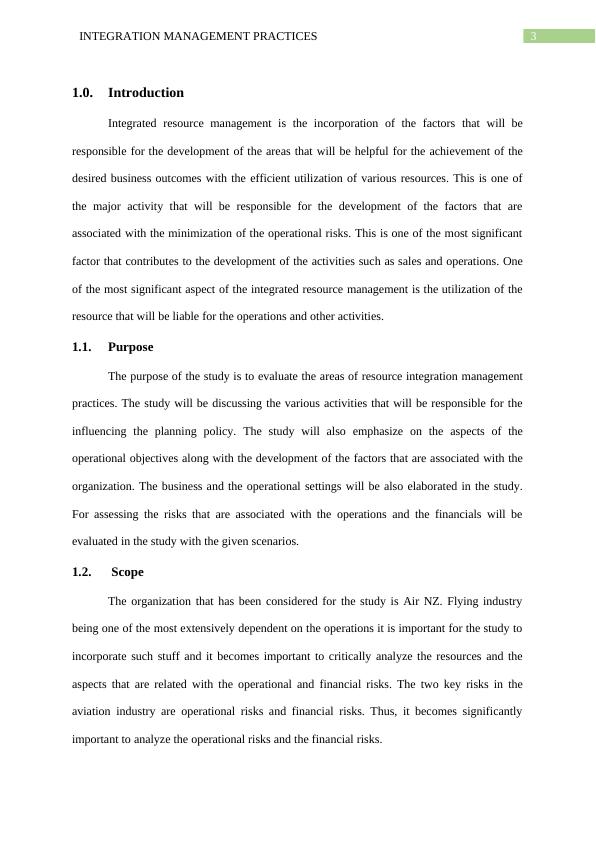
4INTEGRATION MANAGEMENT PRACTICES
1.3. Limitations
There are limitations associated with the study as the articles that will be providing
the key insights on the strategic concepts can be outdated. However, the study will be
focusing one the relevancy of the articles. The study is based on the secondary resources
which creates another limitation which is the biasness of the authors towards their study
which cannot be measured.
1.4. Company Background
Air NZ has been one of the major players in the aviation industry of New Zealand
(Airnewzealand.co.nz, 2019). This has been the flag carrier airline of New Zealand. This has
been one of the most influential company in the aviation industry. The current fleet size of
the company inclusive of the 64 carriers which does not include the subsidiaries. It was
founded in 1940 as the Tasman Empire Airways Limited but in 1965 the company became
Air New Zealand when the government of New Zealand bought 50% of the stake from the
Australia airline (Airnewzealand.co.nz, 2019). Currently the organization is being led by the
chief executive office named Christopher Luxon. The company is having a current total asset
of NZD 7,261 million with a revenue of NZD 5,231 million. The company is currently
having a strong financial structure. The company is currently operating with Airbus A320,
Airbus A320 Neo, Boeing 777 and Boeing 787 (Airnewzealand.co.nz, 2019). The company is
having subsidiaries such as Air Nelson and Mount Cook Airline (Airnewzealand.co.nz,
2019). This company is having a direct competition with the big companies like Qantas,
Etihad, Malaysian Airlines and many more.
1.3. Limitations
There are limitations associated with the study as the articles that will be providing
the key insights on the strategic concepts can be outdated. However, the study will be
focusing one the relevancy of the articles. The study is based on the secondary resources
which creates another limitation which is the biasness of the authors towards their study
which cannot be measured.
1.4. Company Background
Air NZ has been one of the major players in the aviation industry of New Zealand
(Airnewzealand.co.nz, 2019). This has been the flag carrier airline of New Zealand. This has
been one of the most influential company in the aviation industry. The current fleet size of
the company inclusive of the 64 carriers which does not include the subsidiaries. It was
founded in 1940 as the Tasman Empire Airways Limited but in 1965 the company became
Air New Zealand when the government of New Zealand bought 50% of the stake from the
Australia airline (Airnewzealand.co.nz, 2019). Currently the organization is being led by the
chief executive office named Christopher Luxon. The company is having a current total asset
of NZD 7,261 million with a revenue of NZD 5,231 million. The company is currently
having a strong financial structure. The company is currently operating with Airbus A320,
Airbus A320 Neo, Boeing 777 and Boeing 787 (Airnewzealand.co.nz, 2019). The company is
having subsidiaries such as Air Nelson and Mount Cook Airline (Airnewzealand.co.nz,
2019). This company is having a direct competition with the big companies like Qantas,
Etihad, Malaysian Airlines and many more.

5INTEGRATION MANAGEMENT PRACTICES
2.0. Resource Integration
2.1. Resource Integration Practices in Air NZ
Resource integration is one of the major contributor towards the development of the
key factors that will be responsible for the development of the key issues that are related to
the comprehensive planning process. These practices are comprised of the activities such as
planning, utilizing the resources, setting the objectives drawing the strategies for the efficient
utilization of resources. Current resource integration of resources are emphasizing of the
safety of the customers along with creating a frame work that will be liable for the change in
the sustainability. The process of integration is one of the major activity that requires
collaboration. This is one of the major contributors towards the development of the key areas
that will be impacting the operations. There are contributors towards the development of the
aspects that will be responsible for the integration of the resources. The theories tells about
the successful integration of the resources in inclusive of the effectuation theory and the
theory of configuration. These two theories are responsible for enlightening the key
organizational practices that are associated with the integration of the resources. Air NZ
being a part of a competitive environment of the aviation industry it becomes vital for the
organization to deal with effective integration of the resources (Airnewzealand.co.nz, 2019).
The theories that underpins contemporary resource integrations for the Air NZ is stated
below:
2.2. Theoretical Approach
2.2.1. Effectuation
Effectuation theory is one of the most important theory that states about the various
practices that any organization can be adopting the activities that will be liable for the
development of the efficient process (Arend, Sarooghi & Burkemper, 2015). The study states
2.0. Resource Integration
2.1. Resource Integration Practices in Air NZ
Resource integration is one of the major contributor towards the development of the
key factors that will be responsible for the development of the key issues that are related to
the comprehensive planning process. These practices are comprised of the activities such as
planning, utilizing the resources, setting the objectives drawing the strategies for the efficient
utilization of resources. Current resource integration of resources are emphasizing of the
safety of the customers along with creating a frame work that will be liable for the change in
the sustainability. The process of integration is one of the major activity that requires
collaboration. This is one of the major contributors towards the development of the key areas
that will be impacting the operations. There are contributors towards the development of the
aspects that will be responsible for the integration of the resources. The theories tells about
the successful integration of the resources in inclusive of the effectuation theory and the
theory of configuration. These two theories are responsible for enlightening the key
organizational practices that are associated with the integration of the resources. Air NZ
being a part of a competitive environment of the aviation industry it becomes vital for the
organization to deal with effective integration of the resources (Airnewzealand.co.nz, 2019).
The theories that underpins contemporary resource integrations for the Air NZ is stated
below:
2.2. Theoretical Approach
2.2.1. Effectuation
Effectuation theory is one of the most important theory that states about the various
practices that any organization can be adopting the activities that will be liable for the
development of the efficient process (Arend, Sarooghi & Burkemper, 2015). The study states
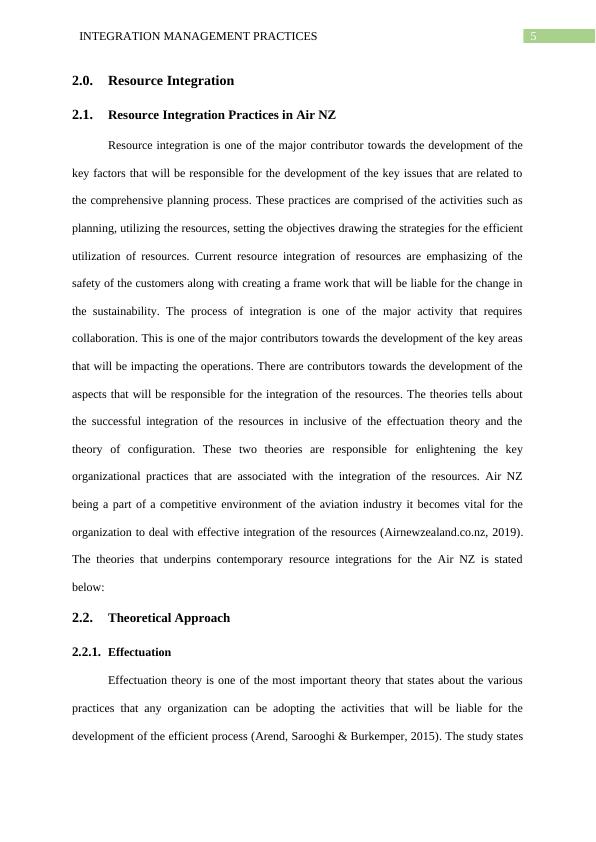
End of preview
Want to access all the pages? Upload your documents or become a member.
Related Documents
Business Report on Air New Zealandlg...
|21
|6815
|90
Resource Integration Management Practices of Air New Zealandlg...
|25
|8222
|204
Internal and External Analysis of McDonald's in New Zealandlg...
|24
|6103
|168
Human Resource Management and Marketing Strategy of ANZ Banklg...
|13
|3116
|134
Financial Performance of Air New Zealand Companylg...
|40
|7049
|282
Value Chain Analysis and Achieving Competitive Advantagelg...
|16
|3485
|178
